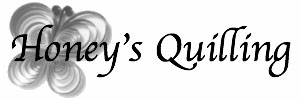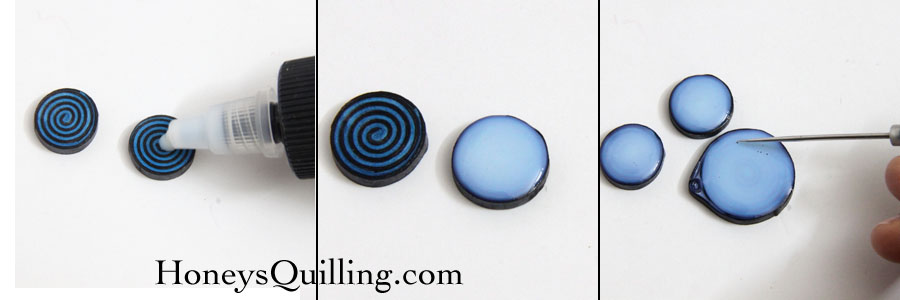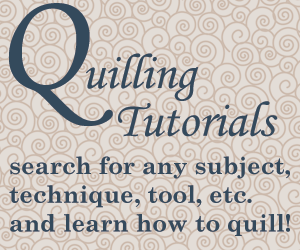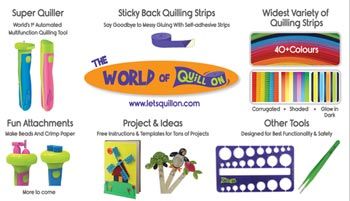Here it is, the definitive post about using PPA for your paper quilled jewelry!
I have a couple posts already about using sealants for paper quilling jewelry, and now I want to do a detailed post about each individual one. So I’m starting with PPA (Perfect Paper Adhesive).
PPA comes in two styles – matte and glossy. They truly live up to their names. Matte is really truly matte and glossy is definitely glossy! I will show you examples of using both of them.
If you have never used PPA before, here is the product description:
Finish Coat – achieves a glossy or matte water resistant smooth finish.
Adhesive – is the finest paper, glass, leather, and collage adhesive available.
Medium– mixes readily with acrylic or latex paint, and dry pigments to form a water-resistant acrylic paint.
Sealant – seals paper and other absorbent surfaces
You can purchase PPA at well stocked craft stores around the world, as well as here on Amazon.
Glossy PPA
Glossy PPA has a beautiful glossy finish! You can use it as a thick layer or thin layer on your paper quilled jewelry as a sealant. You can use it alone or on top of another sealant (I will show and explain the difference).
Here are some photos of two sets of spiral circle jewelry that I made. The blue/black set has a thick layer of PPA. The pink set has a thin layer that I brushed on with a paintbrush. When you use a thick layer it really coats the piece, making it look more plastic-like and very shiny. This is a fun effect. The only downside I see is that it is easy to get fingerprints on it, but not a big deal, just wipe with a cloth. It’s the same with any shiny plastic jewelry. When you use a thin layer you can still see and feel any ridges in the paper, so it doesn’t look as plastic-y, but it is still shiny. Be aware, as noted in the earlier paragraph, that if you apply a thin layer it is best to do it quickly when the glue is out of the bottle and not let the glue sit on a surface for some time before applying it. You can see in my pendant that you can see the brush marks in the surface of the pink pendant. You cannot see the same on the earrings since I applied the PPA to those first. It is not very noticeable unless you look at it at the right angle. That’s why you can see the brush lines in the first photo, but not the next couple, as I photographed at the right angle so you could see the brush marks.

Matte PPA
Now let’s take a look at matte PPA! This gives a very matte look, there is no shine at all to matte PPA. A great choice when you want to make sure that your paper quilled jewelry still looks like paper!
These photos show the difference between a thick and thin layer. Again, for the thick layer I squeezed it on, popping any bubbles with a needle tool. For the thin layer I used a small paintbrush and brushed it on. The thin layer dries a lot more quickly, it even started drying before I could get the photo taken as you can see! The difference between the finished pieces is that you can still see any paper ridges with the thin layer. The thick layer disguises the ridges so you can’t really see/feel them. Of course ridges only happen if the papers you are using aren’t *exactly* the same width, which can happen when you use different colors/different brands together. I personally don’t mind the ridges in most designs, it makes this one look more like wood I think. There doesn’t seem to be as much of a difference between thick and thin for matte as there is for glossy. For glossy it seems there are times it’d be nice to have a thick layer. But for matte, I don’t really see that it would be of benefit. But that’s just me, you can certainly give it a try yourself and see if you prefer it that way!
As mentioned with the glossy PPA, it dries flexible and clear. If you don’t use any other sealant underneath, your final piece will be flexible. The second photo here shows a piece that only has the matte PPA as a sealant. I can push the middle with my finger to make it stick out. But if I release my finger the shape will go back into a disc as it was when I applied the PPA. This will still work fine for jewelry for these solid pieces. But note that if you are using a delicate design, you may want to first put on a base coat that will stiffen your piece.
The left photo below shows two discs made with the same color papers (grey and speck-tacular rose). The one on the left only has matte PPA as a sealant. The one on the right uses liquid matte sealant first and then matte PPA on top. Notice the color difference. This is because liquid matte sealant can darken your paper (not all papers, the ivory/black discs above don’t show this difference). Really this photo is more useful in my future post about liquid matte sealant, but I wanted to show it here as well so you can think about what you use as a base sealant if you choose to go that route. I choose to use liquid matte sealant as I like the way it stiffens the paper, even though it does make it a slight shade darker. You can read more about liquid matte sealant here and here. **added note** another liquid sealer that I found that works to stiffen paper as well as the liquid matte sealant I used to use is this Ceramcoat Liquid Sealer. I’m not sure yet if it darkens the paper or not, I’ll be doing a full post on it soon!
Conclusion
PPA makes a wonderful sealant for your paper quilled jewelry. Whether you want a matte look, or a shiny finish, it has you covered! It is flexible, clear, non toxic, archival (it won’t yellow!), and non sticky. I have been using it for more than 2 years and I have been very happy with it! Let me know if you have any questions and I’ll try to answer them, I may even add the answers to this post! Have you used PPA? Do you like it?
Stick around to visit some more great posts on the blog!
Click here to view free paper quilling tutorials!
Click here to view paper quilling tips and tricks!
Click here to view a list of places to buy quilling supplies around the world!
Click here to view some of my own quilling projects, with tips so you can make your own if you’d like!
*This is NOT a sponsored post. I purchased the PPA matte and gloss myself and am sharing my honest experience in hopes that others find it useful.
*This post contains some affiliate links. If you make a purchase through the affiliate link I get a small percentage (at no cost to you!). Thank you for supporting my blog!
































Hi,
I would like to order the PPE adhesive (both gloss and matte). Can u please tell me how much is the cost?
Regards
chetna
Hi Chetna,
I sell the PPA adhesive in my online shop here: http://honeysquillingshop.com/collections/glues-and-sealants You can order directly from there. The price is there (you can change the price to Indian rupees by choosing it in the menu at the top left corner). Shipping is based on weight and you can see the shipping quote when you click on ‘checkout’
Does the work surface need to be protected? If so, with what?
I use a plastic sheet on my workboard. Any plastic surface will work as a protection.
Another question: When adding jewels or crystals to paper quilled jewelry, should they be in place before using PPA as a sealant or after?
Either way would work, but I think the crystal/jewel would stand out more if it was added afterwards.
Thanks for the information, plastic and afterwards it is. Also, thanks for the prompt reply.
Thanks a Ton for ur info 🙂
Will it be a even coat if i apply these sealent after making Jumka(cone shape earing).
will this leave an odour after drying.
how to apply on these Jumka models using this PPA.
If you are applying PPA to a jhumka use a paintbrush and do a thin layer. If you do a thick layer it may slowly run down the sides while drying and leave a thick layer at the bottom edge or even drips. So as long as you do a thin layer with a brush, it will be an even coat 🙂 It will NOT leave any odour after drying, one of the things I Love about PPA!
I’m beginner in quilling jewellery making, I’m getting big hole in the centre when I make a disc is there any problem with my quilling needle.
Pls reply I’m learning quilling in net.
Hi 🙂 What tool are you using? The bigger the end of your tool, the bigger the hole in the center of your disc. Also if you are winding it very loosely, then it will have a bigger hole as it will expand. You need to wind it firmly enough.
can i use this to seal in images printed by a printer at home?
I don’t actually know. But you can email the creators of this product from http://USArtQuest.com and ask them!
what is the cost of sealant in hyd
I’m sorry, I’m not familiar with hyd, so I’m not sure…
Hi dear,i am really felt frustrated to seal my jhumkas and make it shinning ?i bought varnish from india.its for me not work out !
can you help me.
Hi, sorry to hear that your varnish is not working for you. What brand are you using? I’d of course suggest to use one of the brands that I have mentioned here, or another well known brand. It can be expensive to buy the good ones, but at least you know they will work! Also, a small bottle of sealant can be used for many many jhumkas or other designs.
Hi,
I had ordered PPA gloss finish for myself and a friend of mine. I did not use it yet on my products (which are few dolls and flowers), but my friend who used it on the quilled earrings did not get a very glossy finish.
How do we apply the PPA to get a perfect gloss finish? Should we not use a brush to apply but use it directly? And how many coats are required if we can apply using a brush? Can you help us out..?
There are two types of PPA – matte and gloss. Which did you get? Matte gives a very matte finish and glossy makes it very glossy, as shown in the photos of this post. You only need 1-2 coats with a brush
It was gloss finish. Then I assume I should be little more liberal with the amount I apply on the product 🙂
Yeah, that’d be the next thing to try 🙂 even with a thin layer it will be glossy, but only if you look at it at the correct angle against the light.
Hi how to apply acrylic paint and ppa both on jhummkas.should I mix both and apply it or one by one. And which acrylic paint is best for paper quilling?
You can mix the acrylic paint with the PPA and use it that way, it is made to be able to do that. As for which acrylic paint to use, I have never used any for paper quilling, so I don’ know if some are better than others
Ur creations r awesome. …I want to ask you that can I use PPA as a sealant as well as glue? ?? Is it waterproof? ??
Thank you 🙂 yes, PPA is a great sealant/topcoat for your quilled work. It is very water resistant. All topcoats you see like mod podge, crystal coat glaze, diamond glaze, etc. Are also water resistant. They are not 100% waterproof. For that you need to use something like resin. But water resistant is good enough for quilled jewelry. It will survive falling in a puddle if you pick it up quickly, but it may not survive a trip into the washing machine.
How to use comb to make earrings? ?? Plz send some photos. …
Actually I haven’t yet used the comb to make earrings, I am planning on trying that soon!
Hi, my inglish is not so good but i like reading your posts! Thanks!!
I want to ask about delicate design. You suggest to use matte liquid first. Spray liquid? And after that, shoud i use brush for the ppa? And how much should i pay attention to any corner?? And last one- if i glue the quilling desiges to frame/bristol board etc. Shoud i do something different?
Thanks a lot!!! Like your blog:)
Hi 🙂 I’m glad to hear that you enjoy my blog 🙂 if you are gluing your quilling to a board, then you do not need to put on any sealant. I use sealant only for jewelry, magnets, hair clips, and other projects that I want to last a long time but are not protected by a frame or something. The liquid sealant that I use is not a spray. It can be put into a little spray bottle, and actually I used to use it that way, but a lot of sealant gets wasted that way, so now I just use a little brush. I use a brush for PPA as well. With the liquid sealant I pay close attention and make sure all surfaces and corners are covered (in several light layers). With the final top coat I do my best, but I don’t worry if there are some very tricky small places, as everything should be covered by the sealant
Hi,
This is wonderful blog that I have ever come across. And also you are answering questions very quickly.
I have few queries with using PPA. Here they goes.
1) As I am making Jumkas, and I need them to be stiff, how to apply PPA.? But as per the above information provided, “I always use matte liquid sealant first so that the piece becomes stiff/hard and then when it is dry I apply the PPA on top.”, why to apply PPA after applying matte liquid sealant, if I am doing matte Jumkas..?
If I need glossy finish for my Jumkas and need hard type, then how to apply ?
2) As you said liquid matte finish, which brand is best to use ?
3) As I am a beginner, I have used some local available varnish for my Jumkas and after few days they turned to white color.. which I am totally disappointed with.. Hence need your advise to make wonderful jewelry without color change..
4) If I want to fix some pearls or stones over Jumkas, what would be the best procedure that I need to follow. ? I mean to ask, what to apply and when to apply.
5) Finger prints is one more issue. As you said to wipe out with cloth, still the same issue. From long view its ok.. But closeup they are still visible.
6)I want to make Jewelry with border buddy. There is a problem after making the same.
For example, After making the square with border buddy, and applying varnish or so .. it is becoming stiff as per my requirement. But after few hours, varnish is getting cracked up and falling off like powder and they are becoming soft like normal paper. I want to know how to make these and how to apply sealant. These should be hard matte look. Kindly advise.
After all, I would request you to upload few videos for my questions. And that would be fantastic for everyone who wants to learn.
Thanks,
Harshitha.
Hi Harshitha 🙂
I’m glad you have found the blog useful. Here are the answers to your questions:
1) The liquid sealant is good at making the paper quilling very stiff, but it is not as water resistant as PPA and other topcoats or glazes, so that is why it is best to use another layer on top of it. I use the liquid sealant and then when it is dry I apply either gloss or matte PPA depending on whether I want a glossy or matte finish.
2)The liquid sealant that I am currently using is Ceramcoat All Purpose Sealer which you can find here: http://amzn.to/1KQSFfJ
3) I would suggest not to use those inexpensive sealants that turn whitish. If you purchase brand name products that are well known, you will have good results! PPA, Crystal Coat Glaze, Diamond Glaze, etc. are so much better!
4) There are many ways to apply the pearls and stones. One way is to use your glaze also as the glue. So apply your topcoat and then stick on your stones. You can also wait for your glaze to dry, and then apply the stones with the same glaze as the glue. All of these glazes also work as glue. If you want you can apply a layer of glaze overtop of the stones for a different look.
5) Make sure not to touch your pieces until they are fully dry. You will only get to see the fingerprints if you press fairly hard when it is not completely dry yet. If you want to make sure not to get the fingerprints at all, use a harder glaze. Diamond Glaze is the hardest that I have used, with PPA being next best.
6) If your varnish is cracking and falling off, then it is no good for that purpose. If you use the products I recommended you will not have that happen. Usually I dip border buddy pieces into the liquid sealer, let it dry completely and then paint on the topcoat/glaze of choice.
Yes, I do plan on making videos, hopefully soon! I need to get a video area set up! Let me know if you have any other questions 🙂
i need help .pls suggest me which glue is best to pest posts on paper quilled ear rings..and which varnish may i use to waterproof the jwellery?
Hi 🙂 to glue quilled earrings onto posts I use UHU all purpose glue. I have used super glue in the oats but it didn’t work as well. Any strong glue that says it works on metal should be okay. There are many varnishes for quilled jewelry, where do you live? If you are in India, here is a post about products available there: http://www.honeysquilling.com/which-products-in-india-to-use-to-seal-and-waterproof-your-paper-quilling-jewelry/